Over the last 15 years, 68 million people gained access to improved sanitation in urban areas in sub-Saharan Africa. This is a big achievement. But in the same period the urban population grew by an estimated 167 million. That leaves an additional 99 million urban dwellers without access to improved sanitation.
Since the beginning of this century there has been an increase in the number of people without access to improved sanitation in 42 out of 51 African countries. With the rapid rate of urbanisation on the continent, this number is going to increase.
This means there are 99 million - and rising - urban dwellers who are at increased risk of diarrhoea and other diseases spread by contact with faeces. The lack of sanitation in these areas is causing roughly 50,000 deaths per year (assuming 40% urbanisation).
The health risks associated with poor sanitation include stunting in children as well as malnutrition. This, in turn, has an impact on cognitive development. On top of this, illness from poor sanitation prevents children from going to school and adults from going to work. The economic impact of the lack of sanitation has been estimated at up to US$80 billion annually for Africa.
A new way needed
Unfortunately, what should have been 15 years of investment in sanitation under the Millennium Development Goals or MDGs hasn’t materialised in Sub-Saharan Africa. Sanitation did not initially get the attention it deserved. As result there was lower investment and slower progress globally.
The new goals have tried to address this. The target in the Sustainable Development Goals is to achieve access to adequate and equitable sanitation for all by 2030.
But how will urban sub-Saharan Africa meet the goal of universal access to sanitation if progress is going backwards?
One way is to think about the pathways to universal access, rather than just focusing on a target of universal access. In the past 15 years, the focus has been on the target. And the target has been set by defining access to sanitation as “improved” or “unimproved”. These two measures have been determined by the kind of technology used.
Improved sanitation systems included those that are considered to hygienically separate human excreta from human contact such as flush toilets and pit latrines with washable slabs. But only private latrines - that is where only one household has access - have been included as improved.
On the other hand, shared sanitation has been considered “unimproved” and not providing hygienic separation of human excreta. But it is one of the areas where there was the most progress over the MDG period. In urban areas in sub-Saharan Africa the population using shared sanitation doubled from 64 million to 128 million.

Debunking myths about shared sanitation systems
Shared sanitation systems are a practical option in informal settlements where space is limited and tenure for the household and the community is insecure. And there is a growing body of research that questions the assumption that shared sanitation is unhygienic compared to private latrines.
Research on shared toilets in urban areas in Kampala found that while households with private latrines thought their toilets were less dirty, in reality there was little difference between private toilets and shared toilets when there are fewer than four households sharing.
Research looking at the presence of bacteria had similar results. Recent research from Tanzania demonstrated that shared sanitation systems had significantly less E. coli bacteria at places where people touch the toilets with their hands than private sanitation. In fact, contrary to the concerns about hygiene in shared sanitation, in their regression model, sharing was considered protective against E. coli contamination.
Decisions will be made in the coming months about what indicators will be used to measure progress towards the SDGs. The Joint Monitoring Programme for Water Supply and Sanitation has recommended keeping shared sanitation as unimproved as they consider that the weight of evidence isn’t sufficient to change practices.
A need for a shift in focus
I believe we have to shift the focus from only looking at universal access to including realistic pathways that are addressing the growing demand adequately.
The hard fact is that shared sanitation will continue to be a reality in Africa’s cities. It should therefore be viewed as part of the transition to universal access and, as such, kept on the research and implementation agenda to support this transition.
I accept that there are good reasons why it should be considered as a transitional arrangement only. Most people who have experienced public toilets will attest to the shortcomings.
The two main barriers to shared sanitation being considered adequate in informal urban settlements in East Africa were the lack of privacy and not having 24 hour a day access because caretakers lock the doors at night. But I believe that we can design better shared sanitation to meet the needs of the growing urban populations now, and help give Africa’s urban population a healthier environment.

